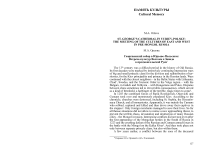St. George's cathedral in Yuriev-Polsky: the meeting of the cultures of East and West in Pre-Mongol Russia
Автор: Orlova Maria A.
Журнал: Новый исторический вестник @nivestnik
Рубрика: Память культуры
Статья в выпуске: 70, 2021 года.
Бесплатный доступ
The first decades of the13th century, on the eve of the Mongol invasion, were a difficult period in the history of Old Russia. Princely feuds and fighting for the Kievan principality led to the fragmentation and weakening of the Russian lands. Oddly enough, this period also witnessed a rise in cultural and spiritual life. That was a time of creation and intensive creative activity, the continuation of the artistic traditions of the 12th century and the emergence of qualitative changes in art. St. George’s Cathedral in Yuriev-Polsky erected in 1230-1234 is one of the most outstanding and, at the same time, the most mysterious works of architecture of the 13th century. This entire period in the history of medieval art is distinguished by a peculiar combination of types and styles from different artistic worlds. In the case of St. George’s Cathedral, it acquired a somewhat paradoxical character, enhanced by the random selection and placement of carved slabs during the restoration of its upper part which collapsed in the 15th century. The specific typological and stylistic samples that guided the customer and the executors still remain unclear. The author attempts to identify the origin of a number of motives of the Cathedral’s carved decoration, with their analogues being found both in Western and Eastern art. The artistic life of Vladimir-Suzdal Russia emerged at a crossroads of various stylistic influences. The author argues that this may explain the implementation of various themes and motives in accordance with local tastes, which form the phenomenon of the facade carving of St. George’s Cathedral - a unique monument of genuinely Russian artistic culture.
Ancient rus, russian orthodox church, political fragmentation, principality, artistic culture, artistic life, temple architecture, cathedral
Короткий адрес: https://sciup.org/149139217
IDR: 149139217 | DOI: 10.54770/20729286_2021_4_127
Список литературы St. George's cathedral in Yuriev-Polsky: the meeting of the cultures of East and West in Pre-Mongol Russia
- Fennell, J.L.I. Russia on the Eve of the Tatar Invasion. Oxford Slavonic Papers: New Series, 1981, vol. 14, pp. 1–13. (In English).
- Fennel, J.L.I. The Tatar Invasion of 1223: Source Problems. Forschungen zur osteuropaischen Geschichte, 1980, vol. 27, pp. 18–31. (In English).
- Manukyan, A. “Dveri zhe i obodverye zlatom zhe kovano”: Fenomen “zolotykh vrat” v khudozhestvennoy kulture domongolskoy Rusi [“And the Doors and Lintels are Bound with Gold”: The Phenomenon of the “Golden Gates” in the Artistic Culture of Pre-Mongol Russia.]. Rodina, 2011, no. 10, pp. 147–149. (In Russian).
- Orlova, M.A. Ob odnom iz motivov rezby Georgiyevskogo sobora v Yuryeve-Polskom [On One of the Motifs of the Carvings of St. George’s Cathedral in Yuriev-Polsky.]. Vestnik Sektora drevnerusskogo iskusstva, 2019, no. 1-1, pp. 30–42. (In Russian).
- Ainalov, D. Geschichte der russischen Monumentalkunst der vormoskovitischen Zeit. Berlin; Leipzig: W. de Gruyter, 1932, 96 p. (In German).
- Erdmann, K. Die Kunst Irans zur Zeit der Sasaniden. Mainz: Kupferberg, 1969, 147 p. (In German).
- Marshak, B.I. Sogdiyskoye serebro: Ocherki po vostochnoy torevtike [Sogdian Silver: Essays on Eastern Toreutics.]. Moscow, 1971, 157 p. (In Russian).
- Meyendorff, J. Byzantium and the Rise of Russia: A Study of Byzantino-Russian Relations in the Fourteenth Century. Cambridge: Cambridge University Press, 1981, 326 p. (In English).
- Vagner, G.K. Skulptura Vladimiro-Suzdalskoy Rusi: g. Yuriev-Polskiy [The Sculpture of Vladimir-Suzdal Russia: The City of Yuriev-Polsky.]. Moscow, 1964, 188p. (InRussian).
- Voronin, N.N. Pamyatniki vladimiro-suzdalskogo zodchestva XI – XIII vekov [Monuments of Vladimir-Suzdal Architecture of the 11th – 13th Centuries.]. Moscow; Leningrad, 1945, 90 p. (In Russian).


